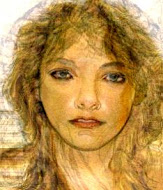* Heritage of Eostar *
by Lark (last updated 22 June 1998ce)
Under the full moon of March, mad hares dance before mating. If you look at her closely, you can see that the moon is a hare, the other self of the Saxon Goddess Eostre and of the Celtic Goddess Andraste. As a hare, she gives omens for battles and for love. Her witches dance by moonlight like hares in the sprouting fields. Her power and her desire are greatest at the full moon nearest the vernal equinox. This is the moon of the Lady's mating-madness, the season of wildness, the moment of flowering, the time of renewal. What you seek at this season, you will surely find. What you pursue will not elude you long. What you plant will grow and flower.
This is the full moon of March, the balance point of day and night, when sun and moon light the skies from dawn until dusk and from dusk until dawn again. This is the season of Summer Finding in the North. Druids celebrate the equinox as Alban Eiler, Light of the Earth. English witches celebrate March 25 as Lady Day, the return of the Goddess from the Underworld. This is the month of the Hag, the Time of the Old Woman, notorious for bad weather. In the Scottish Highlands, each week of March has a name: the Sweeper, the Whistler, the Sharp-Billed One, and the Cailleach-the Hag herself. At this season, the folk who sail the North Sea ask kindness of Aegir and Ran, God and Goddess of weather and tides. Scottish fisher folk go to the shore to ask St. Columba--or Manannan, the sea God--for a bountiful yield.
The Roman year began at the new moon of March. Anna Perenna, Goddess of the turning year, began the month as a crone. At the full moon, she married the young God Mars and became the maiden Goddess Neria. Their union reconciled the lunar and solar years. Priests of Mars, the Leapers, danced and leapt in the streets, clashing weapons against shields. The fires of the hearth Goddess Vesta were lighted using fruit wood and sunlight reflected from a mirror. Vesta herself was crowned with laurel, and her priestesses led a sunwise procession through the city, visiting 27 shrines on the way and casting reed puppets into the Tiber River. Masked flute players roamed the streets in honor of the birth of Minerva, Goddess of wisdom and inventor of the flute.
This is the season when Dionysus danced down from the hills, calling the women to leave their weaving and follow him. Maenads and Bacchantes danced night-long in the mountains, crowned with ivy, mad with wine or spruce ale, and feasting on the tender flesh of Amanita Muscaria. City dwellers celebrated Dionysus and Ariadne, Lady of the Labyrinth, with music and drama contests and festivals of new wine at the full moon. The Phrygian lion Goddess Cybele held two weeks of festival at the equinox. In Rome, she had two festivals, one for the patricians and one for the common people. The Goddess, in the form of a black meteorite brought to Rome from Asia Minor, was paraded through the streets and ritually bathed in the Almo Brook, to the accompaniment of flutes and cymbals.
At the new moon of March, Osiris, consort of the Great Goddess Isis, entered the House of the Moon. Isis, who invented the sail, opened the Mediterranean for navigation in early March. In the ports, her people carried the new ships down to the sea in processions. Isis herself rode through the streets in a ship built to look like her sacred goose. Carnival parades continued the custom with floats called Triumphs carrying images of the gods, especially Dionysus and Ariadne. The Triumphs became the Greater Trumps of the Tarot deck.
In Macedonia, a traditional Carnival play depicts the marriage of a maiden to a man in a bear skin. The bear is killed by a rival, then revived by a Gypsy woman carrying a bundle of grain dressed as a baby. After the play, the actors parade through the town, scattering seeds and calling, "May wheat be ten piastres the bushel!" Bears are said to take human shape during the /winter and return to their own forms in the spring.
Chickens begin to lay in March, and eggs are plentiful by the equinox. After the lean time of the winter, eggs are a promise of plenty. Their yolks symbolize the sun. In Eastern Europe, a straw doll representing winter is dressed and adorned with a necklace of blown eggs, then burned or carried to a river and drowned on Palm Sunday.
The vegetation God Adonis dies and is resurrected at the equinox. In Asia Minor, anemones are called the blood of Adonis. When their blossoms turn the hillsides red, women weep for Adonis in the streets, and the new year begins. In England, women planted Gardens of Adonis--wheat, barley, lentils, lettuce, fennel, privet, and flowers--in pots and took them to church on Easter Sunday. Gypsies decorated a willow tree to honor the Green Man on Easter Monday.
This is the full moon of the Deer Month, the season of birthing. Artemis celebrates her festival of new fawns with cakes shaped like deer. Her priestesses are her hounds, the Alani, who pursue their heart's desire tirelessly over the roughest ground. She celebrates the full moon of April with moon-shaped cakes marked with the quartered circle and left at the crossroads to bless all who pass by. The hot cross buns of Easter tradition were originally her moon cakes.
At the new moon of March, Hera the Queen of Heaven, grown old as Theria the Crone in the long winter, goes down to her sacred spring at Canathos to bathe. She emerges as Antheia the flowering Maiden, one-in-herself, her virginity renewed. Her priestesses are all Heras, glorying in her wholeness, belonging only to themselves. Her priests are all Heracles, her glory and her secret son, the little hero who dwells in the hearts of us all.
In the woods, the Green Man puts forth sprouts from every root and branch. Even in churches, he flowers in carvings of wood and stone, on arches above doorways or hidden beneath benches. "Here, a throat come aleaf, there a branch held aloft," his green fire races through the woodlands and pulses in our blood: "this green source, this welling-forth in ever-widening circles, this 'spring'."*
*from "The Book of the Green Man" by Ronald Johnson
Disclaimer: No one involved in this blog or its contents may be held responsible for any adverse reactions arising from following any of the instructions/recipes on this list. It is the reader's personal responsibility to exercise all precautions and use his or her own discretion if following any instructions or advice from this blog.
















